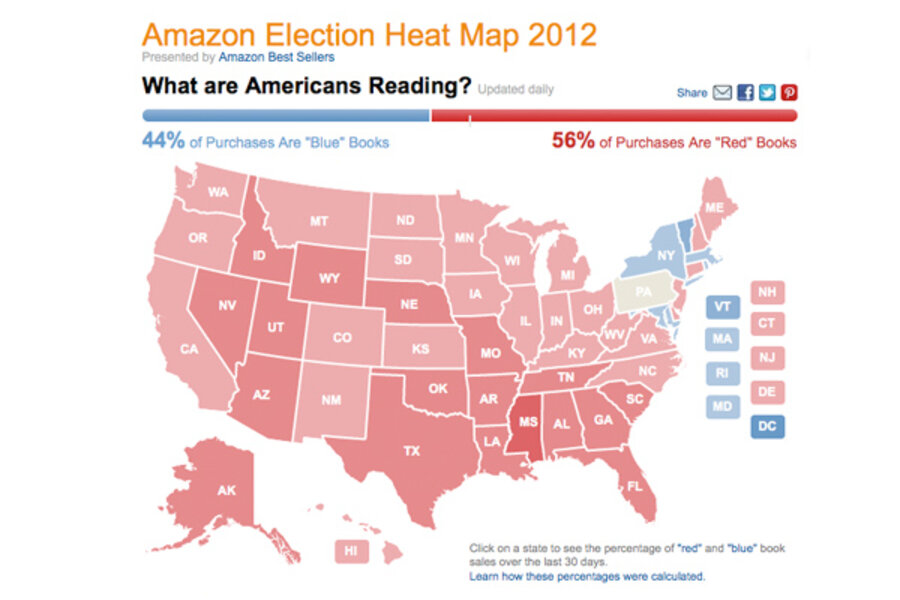Conservative books are leaping off the shelves, says Amazon. Liberal titles, not so much.
Loading...
If political book sales are any indication, Barack Obama is in for a tough ride this November.
That’s according to a new heat map of political books sold, which suggests more Americans are buying “red” books than “blue” books.
Amazon’s new Election Heat Map 2012 uses a rolling 30-day average of book-buying data to classify a state as red or blue depending on whether it has higher liberal or conservative book sales. For politicos and bibliophiles alike, it’s a fascinating geographic glimpse into Americans’ bookshelves – and political reading habits. (Amazon released a similar heat map four years ago in the run-up to the 2008 elections; see our blog on that here.)
But, Amazon is quick to point out, “books aren’t votes, so a map of book purchases may reflect curiosity as much as commitment.”
Currently some 56 percent of political book purchases are “red,” or conservative-leaning, according to Amazon’s heat map, which is updated daily. (Amazon noted that it classified books as red or blue “if they have a political leaning made evident in book promotion material and/or customer classification, such as tags.”) Bestselling “red” titles include “The Amateur,” “Killing Lincoln,” “Leading from Behind,” and “Atlas Shrugged.” (See our recent post on the Ayn Rand-Paul Ryan connection for more on that.)
By comparison, 44 percent of book purchases are “blue,” with top liberal titles including “A People’s History of the United States,” “The New Jim Crow,” “The New New Deal,” and “That Used to be Us.”
“Book sales by geography always have interesting things to say about our states, and an election season is a particularly good time to use this data to help customers follow the changing political conversation across the country,” Chris Schluep, a senior editor at Amazon, told Politico.
Perhaps most striking is that the heat map is awash with red, indicating that conservative-leaning books are outselling liberal-leaning books in the overwhelming majority of states, coast to coast. Only six states – Vermont, Massachusetts, Rhode Island, Maryland, New York, and DC – are selling more liberal books than conservative. Pennsylvania is the bibliophilic equivalent of neutral Switzerland, exactly equally split 50-50 between red and blue reading. The rest of America, including traditionally liberal California, is buying red.
Does the crimson map reflect how Americans will vote this November? Not necessarily. Instead, say industry watchers, it indicates the relative superiority of conservative imprints in seeking out right-leaning books and connecting with readers.
“I can tell you that there are conservative imprints and conservative publishers that are just brilliant at figuring out what kind of books their audience wants to read,” publishing industry analyst Michael Norris, of Simba Information, told Wired. “There just aren’t aggressively left-leaning imprints like that.”
In fact, Amazon’s heat map told a similar story four years ago, when conservative books like “Sarah: How a Hockey Mom Turned the Alaskan Political Establishment Upside Down” were top of the list and the map was similarly awash in red.
Wrote Books Editor Marjorie Kehe last election season, “It might be that publishers of politically 'red' books are scoring big in general. According to a new barometer devised by Amazon.com, books from America’s political right get much wider exposure than those from its left.”
Among Amazon’s findings:
• DC was the “bluest” state, selling the most liberal books at 78 percent liberal, 22 percent conservative.
• Mississippi was the “reddest” state, with 72 percent of purchases coming out “red” and 28 percent “blue.”
• In a head-to-head race, however, Obama still comes out on top. Some 64 percent of Americans are buying “The Audacity of Hope,” compared to 36 percent purchasing GOP contender Mitt Romney’s “No Apology.”
• In the veep race, though, Republican Paul Ryan is trouncing Joe Biden. Some 94 percent of Americans are purchasing Ryan’s co-authored “Young Guns,” compared to just 6 percent buying Biden’s “Promises to Keep.”
We’re enjoying this glimpse into Americans’ political reading habits, but we’re not reading too much into it. After all, four years when Amazon’s heat map was cloaked in red, a decidedly blue candidate won the majority of Americans’ votes.
Husna Haq is a Monitor correspondent.





